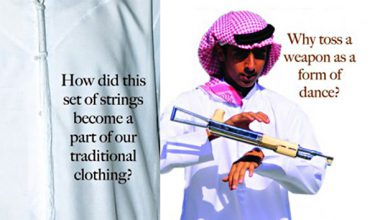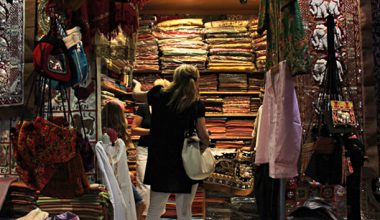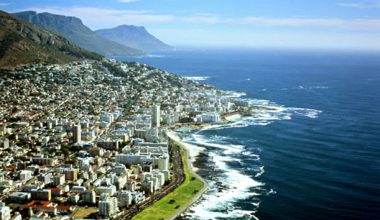 Call it whatever you wish; a “Thobe”, “Dishdasha” or “Kandoura”; all names to describe that one piece of cloth extending from the shoulder to the ankle that makes up men’s national dress and costume in the Gulf.
Call it whatever you wish; a “Thobe”, “Dishdasha” or “Kandoura”; all names to describe that one piece of cloth extending from the shoulder to the ankle that makes up men’s national dress and costume in the Gulf.
Still being worn and regarded an essential wardrobe staple with no question or substitute, this traditional attire has been held onto since antiquity. In the sense that little disparity is found between past designs of the “Thobe” and the modern ones we wear nowadays.
Like in the past, “Thobes” are worn white in the summertime so they would disperse the sun’s heat away from the wearer, and dark in the winter to keep the wearer warm. They have not been sidelined against the current worldwide trend of the white shirt and pants; on the contrary they are regarded more popular over here.
True that “Thobes” differ slightly from state to state here in the Gulf, but the differences aren’t that noticeable, with local Khaleejis and expatriates being the only ones able to notice those differences in reality. (Some don’t even know the difference).

 Qatar
Qatar
The Qatari “Thobe” distinctly features a collar similar to that of a shirt’s. The sleeves end in the same fashion as a formal shirt, with each sleeve fastened with buttons at the cuff. The buttons in the middle of the garment are visible. The chest pocket is positioned on the left hand side. Under the “Thobe, a flannel shirt is worn, which is a white cotton t-shirt, along with long loose white pants (“Mikasser”). But elegance is not complete without a pair of "Tamima" brand leather sandals.
As for the head adornment part of the “Thobe”/national costume, that another thing all on it’s own. The head is covered first with a white skull cap (“Keffiyeh”) with etched designs and little openings to ventilate the hair, some come without the etched holes. This “Keffiyeh” is used to fix the hair in its place and to keep the “Ghutra” (the white sheet-like fabric used to cover men’s heads) from sliding off. The “Ghutra” is made of a piece of white cotton cloth, with some people preferring it to be embroidered at the edges. The black Qatari “Igal” (the circular rope-like attachment that is used o frame the head and keep the “Ghutra” in place) is distinguished by its “Karkusha”, which consists of two strings suspended from the “Igal” on top of the head to the end of the “Ghutra” on the back.
In the winter, the cotton garment of the “Thobe” changes to wool fabrics in a spectrum of colors. The headdress stays the same, but if it gets very chilly, men tend to wear a shawl like “Ghutra” made of luxurious cashmere, or the well-known red-checkered “Ghutra” which is called a “Shemagh”. Naturally, sandals are replaced with formal shoes.
In my opinion as a Qatari, the Qatari “Thobe” design is very expensive to keep with. Why? The fastened sleeve cuff demands cuff links, which has introduced a new competition in which modern youths outdo themselves through the latest cuff link fads with some sporting jeweled cuff links that are encrusted with diamonds and rubies. Similarly, the cuff does not hide the watch, so the competition goes on with the buying and showing-off of the latest and most splendid watches!

Saudi Arabia
It is also called “Thobe”, and its design is similar to the Qatari attire when it comes to the collar, but some prefer an open sleeve cuff. Also, the fabric used in the summer is of the "Zibda" type with a silky texture. The buttons in the middle of the “Thobe” are normally hidden. The hems at the sleeve cuffs and the bottom of the “Thobe” are thinner than those of the Qatari garment. The cut is normally fitted to the body. A great majority wears the “Shemagh”, and the “Igal” is without a "Karkusha."
In the winter, as is the case in Qatar, the “Thobe’s” colors vary, but the red “Shemagh” solidly remains through the yearly passage of seasons. Recently a leap occurred in the Saudi “Thobe” design when prominent local designers such as Yahya Al-Bishri started a revolution with needlework, the introduction of more than one color and fabrics that spread all the way to jeans. Who would have expected the change to start in one of the region’s most conservative states? Would this wave reach other Gulf States? The wave of change has certainly faced a lot of opponents locally, but the youth loved it!
Kuwait and Bahrain
It is called a “Dishdasha” in Kuwait, but a “Thobe” in Bahrain despite both countries having the most similar costumes. In the summer, it is white, the shades of which vary from snow-white to creamlike beige. The collar is circular, without additions, and has one button or two (depending on the length of your neck?). The buttons in the middle of the “Dishdasha”/”Thobe” are often hidden and the sleeves end in an open fashion. The hem on the sleeve cuffs and the bottom are thicker than those of the Saudi “Thobe” with the “Ghutra” being white and the “Igal” coming sans a “Karkusha.”
As is the case with the Qatari and Saudi attire, a cotton t-shirt and long loose pants are worn underneath the “Dishdasha”/”Thoub.” The Kuwaiti man however wears the “Najdiyah” sandal, a traditional sandal that has made a strong comeback in past years to include women as well.
Many Gulf citizens resort to visiting Kuwait in the winter to buy fabrics there for their “Thobes”. Indeed, the quality and variety of wool fabrics in Kuwait cannot be matched anywhere else, so you can find the latest and plushest patterns there.
A new fad in fashion is occurring in Kuwait, which is to wear a shirt with varied colors and patterns under the winter “Dishdasha”, then to fold both sleeves out to show the cuff of the shirt underneath. The collar’s buttons are also opened on the “Dishdasha” to show the shirt’s collar underneath with its different color.

United Arab Emirates
There is a variation here from the categories found above. The UAE calls its men’s costume- the “Kandoura.” It is essentially a long white robe, but without a collar that has a quilted line, like the Qattari “Igal’s” “Karkusha” hanging from the neck line. This quilted line is permeated with the essence of Agarwood so its scent would linger for a long time. The middle of the chest area features triangular embroidery pointing down, but there is no pocket in the left-hand side of chest as is the case with the other Gulf States.
A white t-shirt is worn under the “Kandoura”, and instead of long pants, a long kilt (“Wozar”) is worn from the middle of the waist to the feet. As for the headdress, some in the Emirates wear the white “Ghutra” in the same way as the other states of the region, whilst others wrap it around their heads in the form of a turban.
In the winter, a myriad of different colors appear such as mustard yellow, different shades browns and blues that are unique to the UAE and the “Ghutra” shawl is used instead of the white one. A multi-use cane (“Khaizarana”) is sometimes used as a complementing accessory.
Oman
The Omani “Dishdasha” is similar in design to the Emarati “Kandoura.” But what differentiates the Omani attire is the brightly colored headdress, which is embroidered intricately and with high skill. It is called the “Mussar” and is often made of plush cashmere or cotton. Sometimes an embroidered hat of different colors is substituted for this “Mussar.” To add to the beauty, the Omani man adorns himself with a curved dagger (“Khanjar”) around his waist; it is often made of silver and gold and it is encrusted with rare jewels. The most luxurious kind is the "Saiidi", in reference to the ruling family.
Region-wide Shared Accessories
Of the accessories that are complements to the attire and that are common to the region’s states is the “Bisht.” The “Bisht” is a cloak of different colors, made of camel hair or wool, with its thickness being dependant on the winter’s severity. Embroidered and quilted with golden threads, the “Bisht” is worn over the garment on formal occasions such as weddings and reception parties; it is also regularly worn by Gulf State Leaders in national and international events. Of the other common accessories is the “Misbah”, which consists of 33 beads made of amber, rare jewels or other materials of different colors.
Another special aspect of the attire story rarely seen currently is called the "Shadd", which consists of embroideries with intricate patterns covering the collar and extending to cover the chest buttons up to the middle. The most prominent of its wearers are His Majesty the King of Bahrain Sheikh Hamad ibn Isa Al Khalifah, and the late Emir Sheikh Saad Al Abdullah Al Sabah of Kuwait.
International attention generated towards Khaleeji “Thobes”
Khaleeji mens fashion and national costume is not just a regional aspect; on the contrary other international companies and designers have witnessed the popularity of this trend, and the big demand that is generated in the Gulf for this dress. The manufacturer of “Ghutras” and fabrics spread to the biggest houses of fashion such as Versace, Givenchy and Fendi; they now make exclusive “Ghutras” for Khaleejis that are only sold in regional stores. The Japanese have resorted to producing readymade “Thobes”, but it wasn’t well received, nor popular locally since when it comes to tailoring Khaleejis prefer the custom-made or "bespoke" type. Finally, internationally renown Tom Ford has said to have done a Khaleeji fashion stint and designed a line of “Thobes” geared towards local Khaleejis who wanted to wear designer costumes.
– Fahad Al-Maawda








2 comments
I try to find a lightgrey thoub like the one I have seen in movies. Sometimes when the Berbs(men from near Atlas Mountains) go out in winter time on thei camels into the dessert they vear this clothes . Probably from wool and thick with distinkt pattern from the making.
Where can I get one without going to the actuell area?
I try to find a lightgrey thoub like the one I have seen in movies. Sometimes when the Berbs(men from near Atlas Mountains) go out in winter time on thei camels into the dessert they vear this clothes . Probably from wool and thick with distinkt pattern from the making.
Where can I get one without going to the actuell area?
Comments are closed.